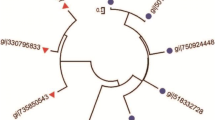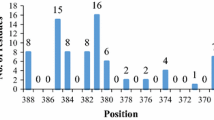Abstract
Lipoxygenase (LOX; EC 1.13.11.12) is an enzyme which is widely used in food industry to improve aroma and rheological or baking properties of foods. A series of studies have proven that the flexible regions negatively relates to the thermal stability of enzymes. In this study, two highly flexible regions, residues20–49 and residues201–206, were modified to improve the thermal stability of LOX from Pseudomonas aeruginosa. Deletion of the first 20 and 30 residues of the former region increased the thermal stability of the LOX by 1.3- and 2.1-fold, respectively. Although deletion of the residues201–206 led to a sharp reduction of both thermal stability and catalytic activity of the enzyme, the residue substitutions with the glycines (G204P, G206P, and G204P/G206P) or even glycine-rich linker (L6/PT) within this region increased the thermal stability of LOX by values ranging from 0.46- to 3.45-fold. To be noted, over 85 % of the specific activity was maintained in all thermally stabilized LOX mutants. Circular dichroism and fluorescence analysis showed that the overall secondary and tertiary structures were not significantly changed by these modifications. To the best of our knowledge, this is the first report on increasing the thermal stability of LOX by protein engineering without remarkably affecting the catalytic rate.





Similar content being viewed by others
References
Aleksandrov AA, Kota P, Cui L, Jensen T, Alekseev AE, Reyes S, He L, Gentzsch M, Aleksandrov LA, Dokholyan NV (2012) Allosteric modulation balances thermodynamic stability and restores function of ΔF508 CFTR. J Mol Biol 419:41–60
Badieyan S, Bevan DR, Zhang C (2011) Study and design of stability in GH5 cellulases. Biotechnol Bioeng 109:31–44
Bradford MM (1976) A rapid and sensitive method for the quantitation of microgram quantities of protein utilizing the principle of protein-dye binding. Anal Biochem 72:248–254
Busquets M, Deroncele V, Vidal-Mas J, Rodriguez E, Guerrero A, Manresa A (2004) Isolation and characterization of a lipoxygenase from Pseudomonas 42A2 responsible for the biotransformation of oleic acid into (S)-(E)-10-hydroxy-8-octadecenoic acid. Antonie Van Leeuwenhoek 85:129–139
Casey R, Hughes RK (2004) Recombinant lipoxygenases and oxylipin metabolism in relation to food quality. Food Biotechnol 18:135–170
Eftink MR, Shastry M (1997) Fluorescence methods for studying kinetics of protein-folding reactions. Methods Enzymol 278:258–286
Fetrow JS (1995) Omega loops: nonregular secondary structures significant in protein function and stability. FASEB J 9:708–717
Gardner HW (1996) Lipoxygenase as a versatile biocatalyst. J Am Oil Chem Soc 73:1347–1357
Garreta A, Carpena i Vilella X, Busquets Abió M, Fusté Munné MC, Fita Rodríguez I, Manresa Presas M (2011) Crystallization and resolution of the lipoxygenase of Pseudomonas aeruginosa 42A2 and phylogenetic study of the subfamilies of the lipoxygenases. In: Muñoz-Torrero D (ed) Recent advances in pharmaceutical sciences. Transworld Research Network, India, pp 247–273
Gershenson A, Schauerte JA, Giver L, Arnold FH (2000) Tryptophan phosphorescence study of enzyme flexibility and unfolding in laboratory-evolved thermostable esterases. Biochemistry 39:4658–4665
Hughes RK, Wu Z, Robinson DS, Hardy D, West SI, Fairhurst SA, Casey R (1998) Characterization of authentic recombinant pea-seed lipoxygenases with distinct properties and reaction mechanisms. Biochem J 333:33–43
Joo YC, Oh DK (2012) Lipoxygenases: potential starting biocatalysts for the synthesis of signaling compounds. Biotechnol Adv 30:1524–1532
Joshi M, Adhikari B, Aldred P, Panozzo J, Kasapis S, Barrow C (2012) Interfacial and emulsifying properties of lentil protein isolate. Food Chem 143:1343–1353
Kato A, Nakai S (1980) Hydrophobicity determined by a fluorescence probe method and its correlation with surface properties of proteins. Biochim Biophys Acta 624:13–20
Kermasha S, Dioum N, Bisakowski B (2001) Biocatalysis of lipoxygenase in selected organic solvent media. J Mol Catal B-Enzym 11:909–919
Laemmli UK (1970) Cleavage of structural proteins during the assembly of the head of bacteriophage T4. Nature 227:680–685
Li B, Yang G, Wu L, Feng Y (2012) Role of the nc-loop in catalytic activity and stability in lipase from Fervidobacterium changbaicum. PloS one 7:e46881
Liu HL, Doleyres Y, Coutinho PM, Ford C, Reilly PJ (2000) Replacement and deletion mutations in the catalytic domain and belt region of Aspergillus awamori glucoamylase to enhance thermostability. Protein Eng 13:655–659
Lu X, Liu S, Zhang D, Zhou X, Wang M, Liu Y, Wu J, Du G, Chen J (2013) Enhanced thermal stability and specific activity of Pseudomonas aeruginosa lipoxygenase by fusing with self-assembling amphipathic peptides. Appl Microbiol Biotechnol. doi:10.1007/s00253-013-4751-y
Lu X, Zhang J, Liu S, Zhang D, Xu Z, Wu J, Li J, Du G, Chen J (2012) Overproduction, purification, and characterization of extracellular lipoxygenase of Pseudomonas aeruginosa in Escherichia coli. Appl Microbiol Biotechnol. doi:10.1007/s00253-012-4457-6
Machius M, Declerck N, Huber R, Wiegand G (2003) Kinetic stabilization of Bacillus licheniformis α-amylase through introduction of hydrophobic residues at the surface. J Biol Chem 278:11546–11553
Malakauskas SM, Mayo SL (1998) Design, structure and stability of a hyperthermophilic protein variant. Nat Struct Biol 5:470–475
Ó’Fágáin C (2003) Enzyme stabilization—recent experimental progress. Enzyme Microb Tech 33:137–149
Poon DKY, Withers SG, McIntosh LP (2007) Direct demonstration of the flexibility of the glycosylated proline-threonine linker in the Cellulomonas fimi xylanase Cex through NMR spectroscopic analysis. J Biol Chem 282:2091–2100
Russell RJ, Gerike U, Danson MJ, Hough DW, Taylor GL (1998) Structural adaptations of the cold-active citrate synthase from an Antarctic bacterium. Structure 6:351–361
Vance R, Hong S, Gronert K, Serhan C, Mekalanos J (2004) The opportunistic pathogen Pseudomonas aeruginosa carries a secretable arachidonate 15-lipoxygenase. P Natl Acad Sci USA 101:2135
Vega M, Karboune S, Kermasha S (2005) Stability of immobilized soybean lipoxygenase in selected organic solvent media. Appl Biochem Biotech 127:29–42
Whitmore L, Wallace BA (2004) DICHROWEB, an online server for protein secondary structure analyses from circular dichroism spectroscopic data. Nucleic Acids Res 32:W668–W673
Whitmore L, Wallace BA (2008) Protein secondary structure analyses from circular dichroism spectroscopy: methods and reference databases. Biopolymers 89:392–400
Zheng B, Yang W, Zhao X, Wang Y, Lou Z, Rao Z, Feng Y (2012) Crystal structure of hyperthermophilic endo-β-1, 4-glucanase: implications for catalytic mechanism and thermostability. J Biol Chem 287:8336–8346
Zhou C, Xue Y, Ma Y (2010) Enhancing the thermostability of alpha-glucosidase from Thermoanaerobacter tengcongensis MB4 by single proline substitution. J Biosci Bioeng 110:12–17
Zhu GP, Xu C, Teng MK, Tao LM, Zhu XY, Wu CJ, Hang J, Niu LW, Wang YZ (1999) Increasing the thermostability of d-xylose isomerase by introduction of a proline into the turn of a random coil. Protein Eng 12:635–638
Acknowledgments
We would like to thank Professor Byong H. Lee for critical reading and suggestions on the manuscript. This work was supported by the Major State Basic Research Development Program of China (973 Program, 2013CB733602), the National Natural Science Foundation of China (No. 31171639), the National High Technology Research and Development Program of China (No. 2011AA100905), Program for Changjiang Scholars and Innovative Research Team in University (No.IRT1135), and the Independent Innovation Program of Jiangnan University (JUSRP11215), the Natural Science Foundation of the Jiangsu Higher Education Institutions of China (Grant No. 12KJD550007).
Author information
Authors and Affiliations
Corresponding authors
Electronic supplementary material
Below is the link to the electronic supplementary material.
ESM 1
(PDF 77 kb)
Rights and permissions
About this article
Cite this article
Lu, X., Liu, S., Feng, Y. et al. Enhanced thermal stability of Pseudomonas aeruginosa lipoxygenase through modification of two highly flexible regions. Appl Microbiol Biotechnol 98, 1663–1669 (2014). https://doi.org/10.1007/s00253-013-5039-y
Received:
Revised:
Accepted:
Published:
Issue Date:
DOI: https://doi.org/10.1007/s00253-013-5039-y




